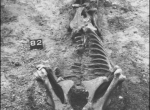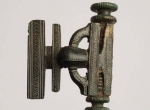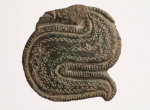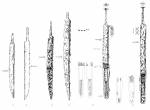Elbląg Group
Elbląg Group, culture unit distinguished by J. Okulicz-Kozaryn (previously materials classified to the E. G. were described as “Old Prussian”) documented during the late →Migration Period in the Elbląg Heights and surrounding area (shores of the Vistula Lagoon). The E. G. emerged as a result of the migration of →Balts population from Sambia first observed during the early Migration Period and intensified at the onset of phase E, who presumably established themselves in sites earlier under →Wielbark Culture settlement. J. Kowalski proposed to distinguish two chronological horizons of the E. G., separated by a hiatus and corresponding to two waves of migration, but this needs substantiation. The decline of the Elbląg Group is still poorly understood: there is solid evidence that the unit continued until the early 7th century – according to observations made before the last war by German researchers – the wane of the tradition of furnishing graves makes it very difficult to date the final phase. The Elbląg Group is known almost without exception from the investigation of cemeteries (key sites: Łęcze – former Silberberg bei Lentzen, Elbląg-Żytno – former Benkenstein-Freiwalde, Elbląg, Moniuszki Street – former Elbing-Scharnhorststrasse, Chojnowo – former Conradswalde, Nowinka - fig. 1-4.). Burial rite: cremated human remains deposited in pits, the grave goods not burnt on the pyre. Very often the human burial rested over an inhumation of a horse (fig. 1.), presumably buried alive in an irregular pit, usually with the bit and bridle, sometimes with a saddle; mostly there was a single horse, resting prone with the head to the south. Frequently a stone pavement of regular shape was laid over the grave. Furnishings: brooches distinctive for Balt cultures (with a lateral bar on the foot – Schlusskreuzfibel - fig. 2; local wire forms of a very simple design), imitations of bow brooches, Sambian (?)equal-armed brooches, imported Scandinavian S-shaped brooches - fig. 3., rings with a hook rings, roughly worked amber beads and lumps of raw amber, belt sets (buckles with a crossbar on the prong – Kreuzdornschnalle, kidney-shaped buckles, openwork mounts, strap-ends: late →Tongue-shaped strap-end and →Lancet-shaped strap-end), weapons (spearheads, one-edged swords, type seax, with scabbards, some decorated with embossed foil plating, riveted spurs - fig. 4.), vessels (mostly hand-built flask forms), tools (knives). E. G. is definitely eclectic, with a domination of Balt (Sambian) traits, which brings to mind associations with the →Vidivarii . The most recent dates of the first phase of the port-of-trade at Janów Pomorski (medieval Truso) suggest that the people of Elbląg Culture were a settlement hinterland for this centre, at least during the earliest stage of its existence. It is possible that the people of the same group built the first earthworks (e.g., Tolkmicko) which are distinctive for the landscape of the Elbląg Heights mainly during the Middle Ages.
BK
Literature: R. Dorr, Die Gräberfelder Silberberge bei Lenzen und bei Serpin, Kreis Elbing aus dem V.-VII. Jahrhundert nach Christi Geburt, Elbing 1898; B. Ehrlich, Schwerter mit silberbeschlagenen Scheiden von Benkenstein, Kr. Elbing, und einige west und ostpreuβische Vergleichsstücke, Sitzungsberichte der Altertumsgesellschaft Prussia 29, 1931, p. 16-46; B. Ehrlich, Elbing, Benkenstein und Meislatein. Ein neuer Beitrag zur Trusoforschung, "Mannus" 24, 1932, p. 399-420; J. Okulicz, Pradzieje ziem pruskich od późnego paleolitu do VII w. n.e., Wrocław-Warszawa 1973; W. Neugebauer, Von Truso nach Elbing. Leitlinien der Frühgeschichte des Elbinger Raumes, "Elbinger Hefte" 34, 1975, p. 9-49; J. Kowalski, Chronologia grupy elbląskiej i olsztyńskiej kręgu zachodniobałtyjskiego (V–VII w.). Zarys problematyki, [in:] P. Szymański, A. Żórawska (Ed.), Barbaricum 6, Warszawa, p. 203-266; B. Kontny, J. Okulicz-Kozaryn, M. Pietrzak, Nowinka, Site 1. The cemetery from the Late Migration Period in the northern Poland, Gdańsk-Warszawa 2011; B. Kontny, Trade, salt and amber. The formation of Late Migration Period elites in the 'Balti-culti' area of northern Poland (the Elbląg group), "Archaeologia Baltica" 17, Klaipėda 2012, p. 60-76.
-

 full resolution
full resolution
Fig. 1. Horse grave at Nowinka, gr. 82 (Kontny, Okulicz-Kozaryn, Pietrzak 2011).
-

 full resolution
full resolution
Fig. 2. Nowinka grave 17, (Kontny, Okulicz-Kozaryn, Pietrzak 2011).
-

 full resolution
full resolution
Fig. 3. Nowinka, grave 17, scandinavian import (Kontny, Okulicz-Kozaryn, Pietrzak 2011).
-

 full resolution
full resolution
Fig. 4. Nowinka, swords Sax-type (Kontny 2012).


